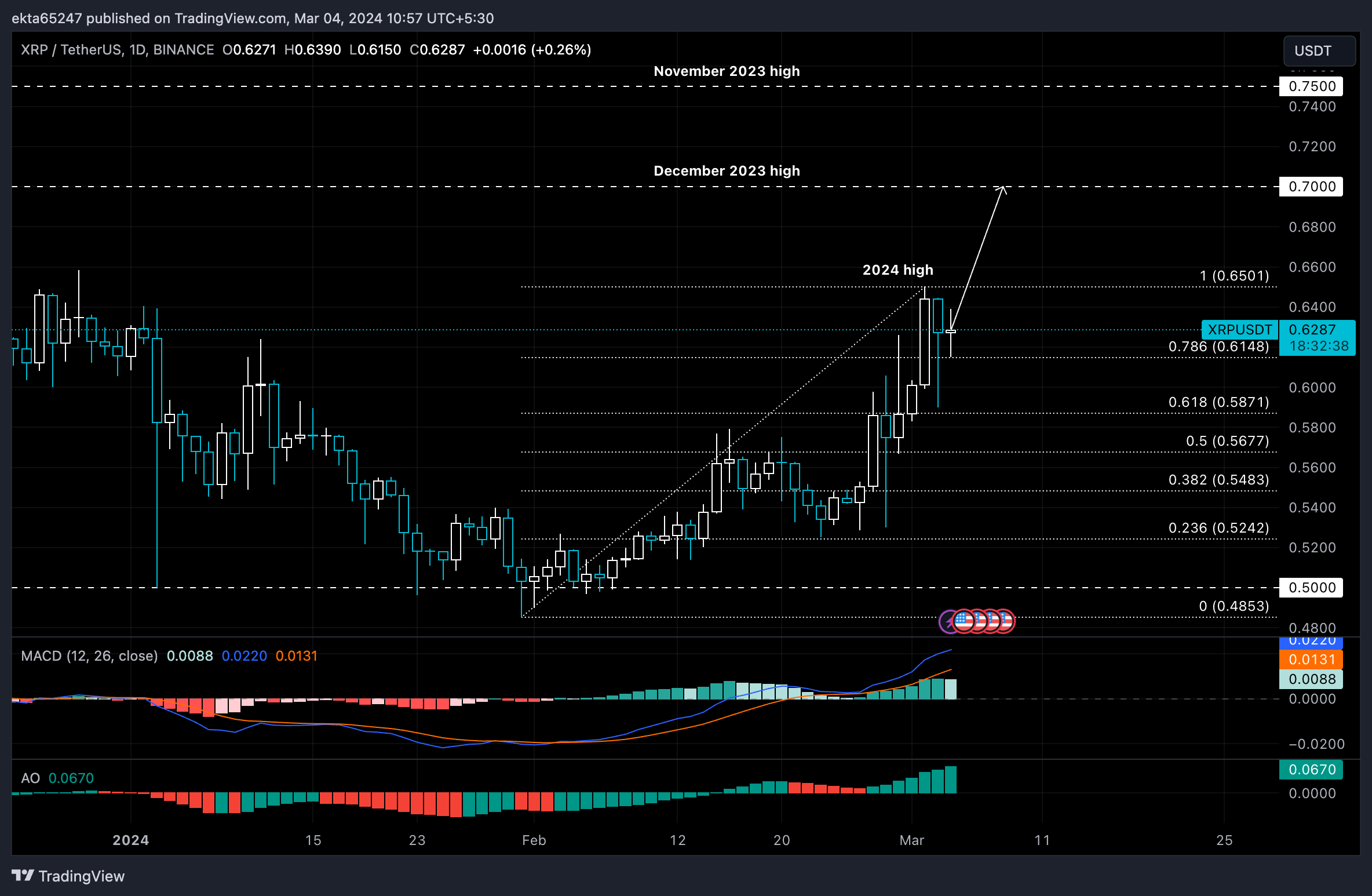XRP price hits new yearly high at $0.65, attorney says Ripple’s influence on XRP is decelerating
- XRP price hits a peak of $0.65 on Saturday, the altcoin has sustained above $0.63 on Monday.
- Attorney Bill Morgan pointed out that Ripple’s influence on the altcoin is declining gradually as its store of XRP reduces.
- Downward pressure on XRP price is likely lessened by Ripple’s escrow of nearly 55% of the total possible supply.
XRP price climbed to a new 2024 high of $0.65 on Saturday and suffered a minor pullback to $0.63, early on Monday. The altcoin has sustained above the psychologically important level of $0.60 amidst developments in the SEC v. Ripple lawsuit.
Attorney Bill Morgan, a Ripple proponent, believes that it is likely that Ripple’s influence on XRP price declines as its store of the altcoin reduces. Further, the escrow set up by the payment remittance firm could make XRP supply more predictable, likely reducing negative impact on XRP price.
Also read: XRP price jumps to $0.62 while Ripple faces pressure from two legal battles
Daily Digest Market Movers: Ripple’s influence on XRP price could reduce slowly
- XRP price sustained above a key psychological level of $0.60 and established a new yearly high over the weekend.
- Attorney Bill Morgan commented on the Ripple-related court documents circulating on social media platform X, and stated how the payment remittance firm’s influence on XRP price is likely on a gradual decline.
- The crypto expert cites two reasons for the decline, the first being Ripple set up an escrow where the firm locked nearly 55% of XRP supply to make it predictable. This is as per the data on XRPLedger’s official website, updated nearly a month ago.
- The blog reads: “To provide additional predictability to the XRP supply, Ripple has locked 55 billion XRP (55% of the total possible supply) into a series of escrows. These escrows are on the ledger itself and the ledger mechanics, enforced by consensus, control the release of the XRP.”
- The second reason is that Ripple’s XRP holdings are on a gradual decline and as the payment remittance firm’s XRP reserves diminish, its influence on the altcoin could reduce further.
- Key deadlines for the SEC v. Ripple lawsuit are the regulator’s opening brief deadline of March 22, 2024. This is the amended deadline after the SEC requested the court for an extension.
Technical Analysis: XRP price could rally to $0.70
XRP price is currently in an uptrend, the altcoin hit a new 2024 high of $0.6501, on March 2, as seen in the chart below. The altcoin is likely to rally towards its December 2023 peak of $0.7000. XRP price needs to flip resistance at $0.6501 into support to rally to its $0.7000 target.
The Moving Average Convergence Divergence Indicator (MACD) and the Awesome Oscillator (AO) both support XRP’s recent gains and the bullish thesis for the altcoin.

XRP/USDT 1-day chart
XRP price could find support at the 78.6% Fibonacci retracement of its rally to its new 2024 peak, at $0.6148, in the event of a decline in its price. A daily candlestick close below the 78.6% Fibonacci retracement could invalidate the bullish thesis for XRP price.
Bitcoin, altcoins, stablecoins FAQs
What is Bitcoin?
Bitcoin is the largest cryptocurrency by market capitalization, a virtual currency designed to serve as money. This form of payment cannot be controlled by any one person, group, or entity, which eliminates the need for third-party participation during financial transactions.
What are altcoins?
Altcoins are any cryptocurrency apart from Bitcoin, but some also regard Ethereum as a non-altcoin because it is from these two cryptocurrencies that forking happens. If this is true, then Litecoin is the first altcoin, forked from the Bitcoin protocol and, therefore, an “improved” version of it.
What are stablecoins?
Stablecoins are cryptocurrencies designed to have a stable price, with their value backed by a reserve of the asset it represents. To achieve this, the value of any one stablecoin is pegged to a commodity or financial instrument, such as the US Dollar (USD), with its supply regulated by an algorithm or demand. The main goal of stablecoins is to provide an on/off-ramp for investors willing to trade and invest in cryptocurrencies. Stablecoins also allow investors to store value since cryptocurrencies, in general, are subject to volatility.
What is Bitcoin Dominance?
Bitcoin dominance is the ratio of Bitcoin's market capitalization to the total market capitalization of all cryptocurrencies combined. It provides a clear picture of Bitcoin’s interest among investors. A high BTC dominance typically happens before and during a bull run, in which investors resort to investing in relatively stable and high market capitalization cryptocurrency like Bitcoin. A drop in BTC dominance usually means that investors are moving their capital and/or profits to altcoins in a quest for higher returns, which usually triggers an explosion of altcoin rallies.
